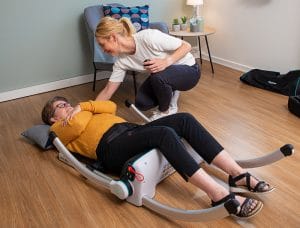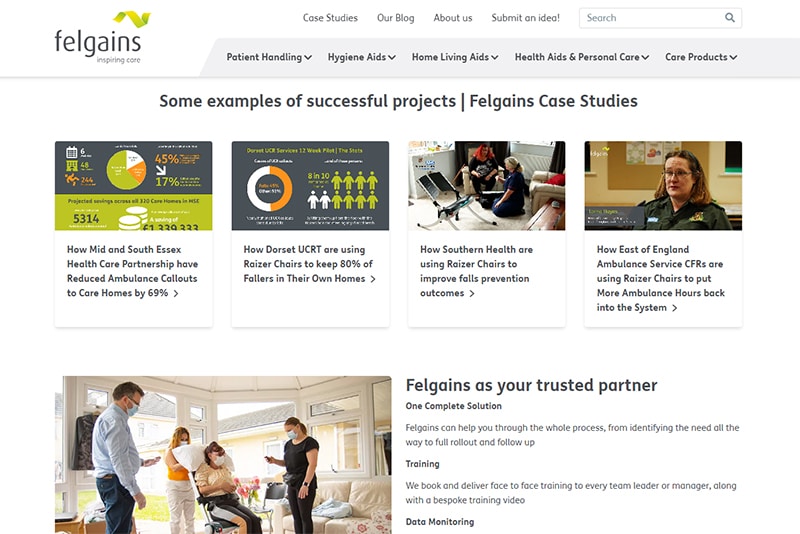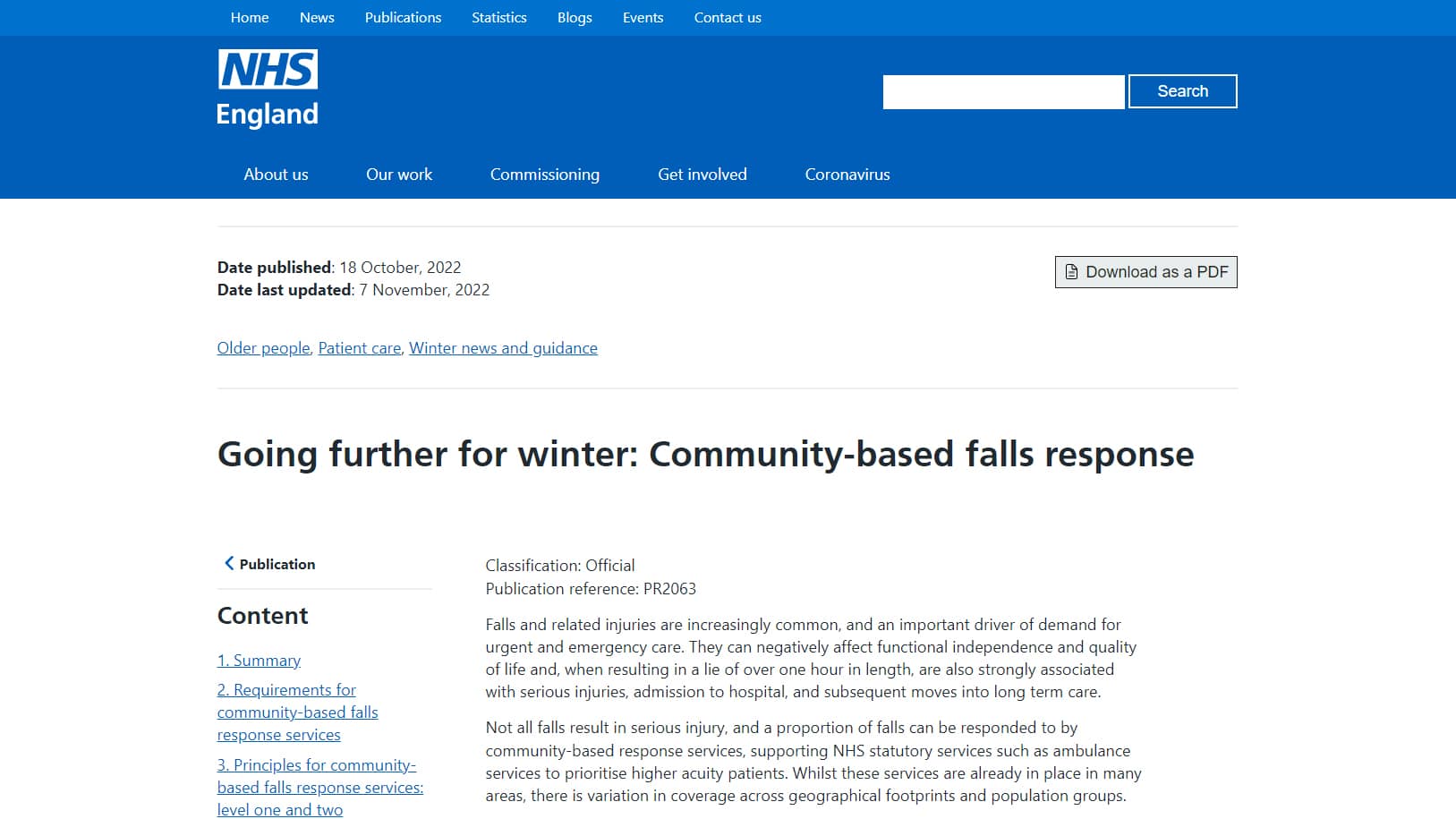Implementing community-based falls response | What are the key parts of the NHSE guidance?
‘Going further on winter resilience plans’
In October 2022, NHS England set out guidance titled ‘Going further on our winter resilience plans’.
Against a backdrop of winter nearing and the situation in emergency care expected to get even tougher over the coming weeks and months, this guidance sets out actions ICBs and NHS Trusts should take to put in place a community-based falls response service for people who have fallen at home, including care homes.
The current pressures on the ambulance service are well documented, and the delays in ambulance response times are increasing the number of long lies experienced by persons who fall. Ambulance services are not commissioned to provide falls response when there is no major injury or illness. This is where the NHSE guidance comes in: setting out ways to use non-ambulance resources – reducing the pressure on the ambulance services whilst improving care for patients.
The 22 page document on implementing community-based falls response is a lot to digest so, in this article, we will be picking out four key parts and showing examples of where this has been implemented successfully.
Webinar Recording | Going further for winter: How to implement community-based falls response
|
We went into the NHS guidance in detail in our webinar ‘Going further for winter: How to implement community-based falls response’
|
2.6: How falls will be triaged
When older people fall in their own home, they rarely have any resources to get themselves back up – resulting in many ambulance call outs to uninjured patients. To ensure an ambulance response is only initiated when necessary, NHS England have set out a triage system with 3 levels;
Level 1: no known Illness or injury
Where there’s no known injury/illness (they just need lifting up off the floor) there should be a non-clinical response. The advice here is to use Tech providers, CFRs and other voluntary organisations like Fire Services and St. John’s Ambulance to respond and lift these people from the floor. Find out how South Western Ambulance Service Trust managed 77% of incidents with CFRs here.
Level 2: minor injury or illness
Where there’s a minor injury/illness, such as skin tears, the Urgent Community Response (UCR) Team should respond. This team will be able to assess the fallen person, lift them from the floor and then coordinate wraparound support from other community-based teams to keep that person at home. Find out how Dorset UCRT kept 80% of fallers at home here.
Level 3: Serious injury or illness
This is the only falls response the ambulance service should be doing. Level 1 and 2 represent new guidance, but this tier stays confirms that the ambulance service is indeed commissioned to respond to serious injuries and emergency situations.
4.2: Management of falls in care homes
As the NHSE guidance points out, falls are three times more common among care home residents than in people of a similar age living in their own homes (Public Health England. Falls: applying all our health.) This makes care homes a key part of any falls response programme.
Section 4.2 also highlights how collaborations between Care Homes, ICBs and equipment providers “have been shown to safeguard residents who fall, support care staff in their decision making after a person has fallen, and to reduce the cost of post-fall response to the health and social care system”. For example, the Felgains partnership with Mid and South Essex ICS resulted in a 69% reduction in ambulance callouts to care homes.
The guidance states that ICBs should provide care homes with falls lifting equipment and a post falls decision making tool and a post falls decision support tool to overcome the common challenge of non-clinical staff being unsure whether it is safe to lift a person who has fallen.
This brings us to the next point …
4.3: Appropriate lifting equipment and post falls decision support tools
To effectively implement community-based falls response, organisations need appropriate lifting equipment that can assist caregivers to quickly and easily lift fallen persons up from the floor – equipment such as the Raizer 2 Lifting Chair.
What is the Raizer 2 Lifting Chair?The Raizer 2 (mentioned in the NHSE guidance) is a motorised lifting chair that assembles around a fallen person and lifts them up to a seated or perching position. It is easy to assemble and use for the caregiver, and it is safe, smooth and very reassuring for the fallen person.
|
 |
Why the Raizer 2?
The Raizer 2 Lifting Chair is easily assembled around the fallen person, minimising the manual handling required. It then safely lifts the fallen person smoothly into a sitting or perching position with minimal noise. This gives the fallen person the dignity they deserve, and helps care staff respond quickly and safely to falls.
6.1: measurement and metrics to support implementation
When it comes to the Progress and Impact metrics that NHS England will be monitoring, one example is metric 4: “Number of care homes that have falls equipment and trained staff to support falls management and pick up”. By increasing the number of care homes equipped to respond to falls, the number of ambulance callouts to care homes can be greatly reduced, helping ICBs to meet impact metric 5: “Decrease in the number of 999 call outs from all adult care homes related to falls.”
For example, an ICB that recently rolled out Raizer 2 Lifting Chairs into care homes have reduced the percentage of falls in care homes resulting in an ambulance callout from 55% down to 13% (case study coming soon). You can find out more about the success our customers have had on our case studies page here.
The Felgains Falls SolutionHere at Felgains, our Falls Vision is that there should be zero unnecessary ambulance callouts to non-injury or minor injury falls in care settings and the community. We are working with many organisations across health and social care to implement community-based falls response and prevention solutions that enable better care.
|
 |
Reuben Bush
Reuben joined the Felgains team in August 2019, bringing with him passion and experience in marketing and design – from a rather different sector. His focus is now on improving each and every touchpoint of our customer experience and building a vast following of raving fans! He loves road cycling, and also happens to have rather a weakness for food – he’s a bona fide chocoholic!
